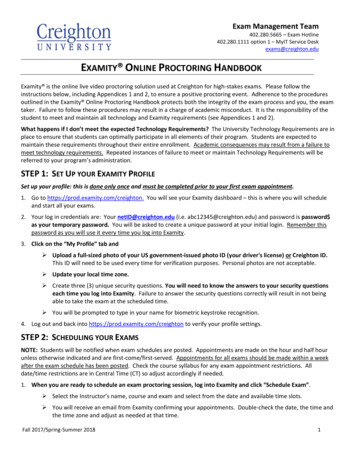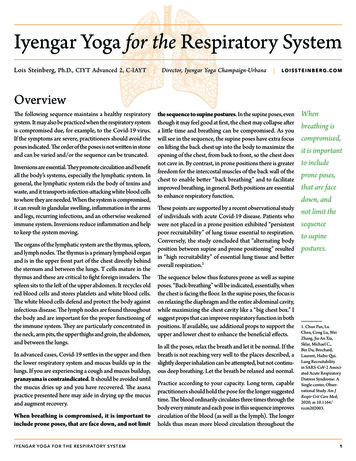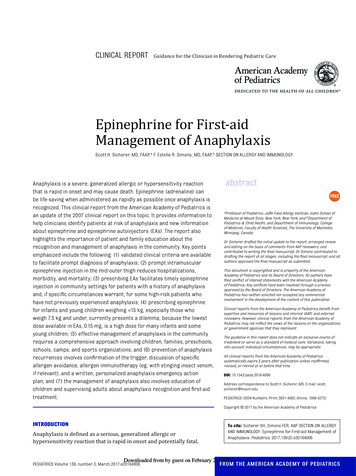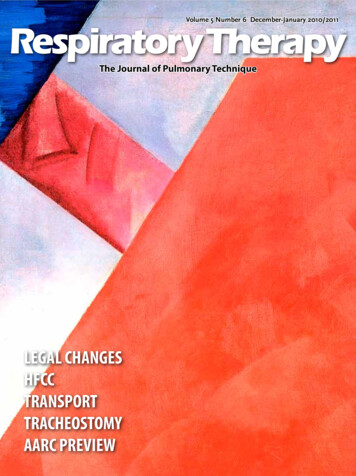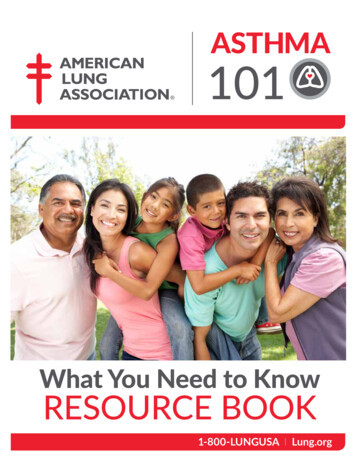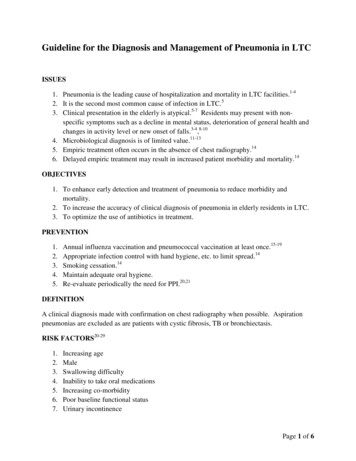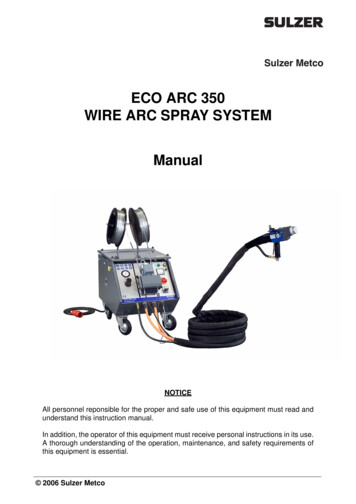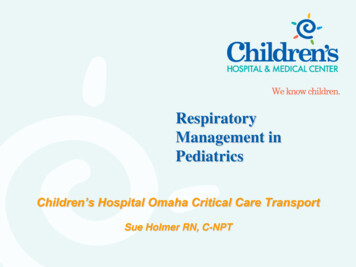
Transcription
RespiratoryManagement inPediatricsChildren’s Hospital Omaha Critical Care TransportSue Holmer RN, C-NPT
Objectives Examine the differences between thepediatric and adults airways. Recognize respiratory distress andimpending respiratory failure. Discuss management of respiratorydistress and respiratory failure. Case Scenarios.
Children are not small adults Children are still growing in every way.Their bodies are different, they perceivethings and communicate differently, andthe long term implications of treatmentare not the same.
Respiratory EmergenciesPediatric RespiratoryEmergencies # 1 reason forpediatric hospitaladmissions. # 1 cause of deathduring the first year oflife with the exceptionof congenitalabnormalities.
Early Intervention is CriticalRespiratory DistressRespiratory Failure/ShockCardiopulmonary FailureCardiopulmonary Arrest
Pediatric y80%Most pediatric cardiopulmonary arrests begin asrespiratory failure or respiratory arrest.Decrease respiratory reserve Increased O2 demand Increased respiratory failure risk
Respiratory Emergencies inPediatricsAirway Diseases Croup, epiglottitis, asthma, bronchiolitis,foreign body aspiration, bronchopulmonarydysplasia.Lung Tissue Diseases pneumonia, ARDS, aspiration, pulmonarycontusionNon-respiratory causes CNS depression, musculoskeletal disorders,thoracic disorders or injuries, shock
Why are children morevulnerable? Obligate nose breathers until 6 monthsLarge tongueLymphoid tissue achieves adult size at 2Large, anterior epiglottisNarrow subglottic regionFewer alveoliSmaller airways: Hagen-Pouiselle’s LawDecreased cartilage in airwaysIncreased chest wall complianceIncreased metabolic rate, increased O2 consumptionTypical oxygen consumption 6-8 ml/kg/min in achild vs. 3-4 ml/kg/min in adult
Pediatric Airway
Airway ResistanceFull Term Newborn Airway1mm of edema, the diameterwill be 44% of normal.Adult Airway1mm of edema, the diameterwill be 81% of normal.Poiseuille’s lawIf radius is halved,resistance increases 16foldResistance increases 3x in an adultand 16x in an infant.R 8nl r4
Adult Airway VS. PediatricAirwayAdultPediatric
The Licorice Airway Please bite a small piece off to top andbottom of your licorice. We will nowperform a test on your airway.– Breath in and out of the licorice for 30 seconds.
Airway ManagementPositionPositionPosition
Airway Positioning“Sniffing Position”In the child older than 2 yearsTowel is placed under the head
Airway Position - Children 2yrs
Airway Position - Children 2yrs
Pediatric Without an “A” you will not get a “B”.
Airway Management “A” Open it correctly! Position the patient in the neutral, supineposition. Use the head tilt, chin lift to open the airwayand place the patient in a “sniffing” position.Use a shoulder role. If you can not open the airway: Reposition! Clear the airway by suctioning any secretionswithin the mouth or nose.
Airway AssessmentOPEN and CLEARAble to MaintainUnable to Maintain
Maintaining the PediatricAirway Nasal Airway Oral Airway Bag Masking Intubation
Foreign Bodies ALWAYS consider a foreign body as acause of Respiratory Distress. Usually will have a SUDDEN onset.
Signs of Respiratory Distress Tachypnea Tachycardia Grunting Stridor Head bobbing FlaringInability to lie down AgitationRetractionsAccessory nosis
Signs of Impending RespiratoryFailure Reduced air entrySevere workIrregular breathing or apneaCyanosis despite Oxygen deliveryAltered Level of ConsciousnessDiaphoresis
Respiratory Failure Respiratory Failure is the inability of theairway and lungs to meet the metabolicdemands of the body.Hypoxic Respiratory FailureInadequate oxygenationCan’t Get Oxygen inHypercarbic Respiratory FailureInadequate ventilationCan’t Get CO2 out
Nasopharyngeal AirwayLength: Nostril to TragusContraindications: Basilar skullfracture CSF leak Coagulopathy
Endotracheal tube as nasal airwayA regular ETTcan be cut andused as anasal airway
Adjuncts: Oral AirwayWrong size: Too Long
Adjuncts: Oral AirwayWrong size: Too Short
Adjuncts: Oral AirwayCorrect size
Bag Mask Ventilation
Intubation: Indications Failure to oxygenateFailure to remove CO2Increased WOBCardiovascular failureNeuromuscular weaknessCNS failure
Laryngoscope BladesMacintoshMiller
Airway Open? Able to maintain? Position andAssess? Bag/Mask? Intubation?Pediatric Airwaywith inflammation
A Closer LookNormal Pediatric Airway
A Closer LookAbnormal Pediatric Airway
ET Tube SizingAgeNewborn3 mos1 yr2 yrskg3.56.01012ETT3.53.54.04.5Length (lip)9101112Children 2 years:ETT size:ETT depth (lip):(Age 16)/4Length of tube x 3 (Approximately)
Intubation TechniqueBetter inyounger childrenwith a floppyepiglottisStraight Laryngoscope Blade – used topick up the epiglottis
Rapid Sequence Intubation When: Intubation is emergent and thereis concern for aspiration Why: Obtain airway control rapidly andminimize aspiration risk How:– All necessary intubation equipment andpersonnel– Preoxygenate– Rapidly acting sedative, analgesic andneuromuscular blocking agent arePresentation Template 2402/15/2012
Rapid Sequence Intubation When: Intubation is emergent and thereis concern for aspiration Why: Obtain airway control rapidly andminimize aspiration risk How:– All necessary intubation equipment andpersonnel– Preoxygenate– Rapidly acting sedative, analgesic andneuromuscular blocking agent arePresentation Template 2412/15/2012
Deterioration after Intubation Displaced tube Obstructed tube Pneumothorax Equipment
Respiratory Case ScenariosLet’s manage somepatients together
Case scenario 1 3 month old is admitted to the hospitalwith a runny nose, poor appetite, andfrequent coughing.Classify patient
Scenario 1 Assessment
Scenario 1 AssessmentVitalsH.R. 136R.R. 60WOB Intercostal and subcostal retractionsB.S. Noisy breathing (crackles and wheezing)SpO2 on Room Air 88%Diagnosis
Respiratory Syncytial Virus(RSV) RSV is a very common virus that infectshalf the children during their first year oflife. Symptoms include wheezing, nasalcongestion, rapid breathing, cough,irritability, retractions, poor feeding,sluggishness, and fever. Synagis is given as a prophalytictreatment to children with the highestrisk for severe RSV.
RSV in the AirwayPremature lung with RSV
Scenario 1 Treatment “A” Airway Management Secretion Management* Suction before all feeds. “B” Breathing Oxygen Therapy “C” Circulation Hydration Treat symptoms Prophylaxis (Synagis)SUCTION
The Nose Nose is responsible for 50% of totalairway resistance at all agesInfant: blockage of nose respiratory distress
Case Scenario 2 A 2 year old patient is admitted to theED with lethargy, poor appetite for 3days, fever, increasing respiratorydistress.Classify Patient
Scenario 2 Assessment
Case Scenario 2VitalsH.R. 172R.R. 58WOB substernal retractionsB.S. rales, diminished basesSpO2 on Room Air 80%Diagnosis
Scenario 2 Treatment “A” Airway Management Position child to Open Airway Clear Airway “B” Breathing Oxygen Therapy “C” Circulation Hydration
Case Scenario 2 30 minutes later:VitalsH.R. 186R.R. 66WOB substernal and intercostal retractionsB.S. diminishedSpO2 on 10 liter O2 mask 90%X-ray hyperinflation, right lower lobe atelectasisCap gas results:pH 7.26, CO2 75, O2 53
Case Scenario 2 Chest X-ray
What is plan B?L aryngealM askA irway
Needle Cricothyrotomy A “quick” fix, buys some time Used when you can’t intubate orventilate
King Airway Backup Airway Inserted Blind .
Case Scenario 3 7 year old child is brought to theEmergency Department with a chiefcomplaint of SOB.Classify
Case Scenario 3VitalsH.R. 132R.R. 28WOB substernal and intercostal retractionsB.S. decreasedSpO2 on Room Air 87%Diagnosis
Asthma Statistics 23 million Americans currently haveAsthma. Number of children who currently haveAsthma: 7.0 million. Students with Asthma miss nearly 13million school days every year due toillness.
Scenario 3 Treatment “A” Airway Management Oxygen Sitting Position, Position of Comfort “B” Breathing Albuterol 0.5 ml and more bronchodilators Steroids Encourage Coughing “C” Circulation Hydration
Special Populations Tracheotomies– Stay “CALM”!!
Special Populations Cystic Fibrosis– SUCTION, Position of Comfort, Cough– SUCTION– SUCTION
It is all about the ABC’s Airway Breathing CirculationRecognize the signs of respiratorydistress and use your ABC’s.
Questions?
Thank You!!!
respiratory failure or respiratory arrest. Decrease respiratory reserve Increased O2 demand Increased respiratory failure risk . Respiratory Emergencies in Pediatrics Airway Diseases Croup, epiglottitis, asthma,

